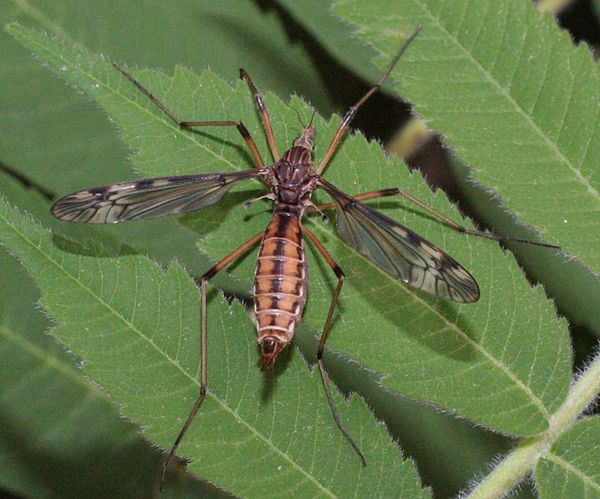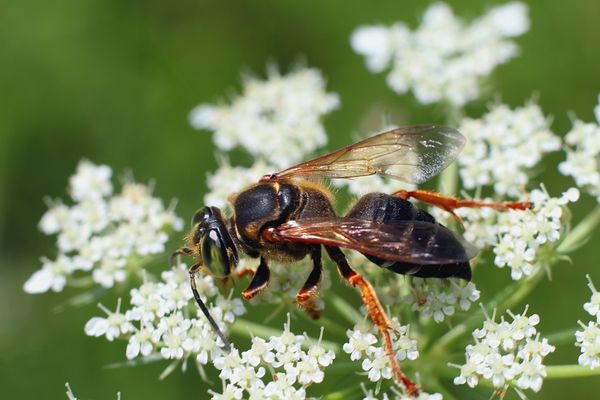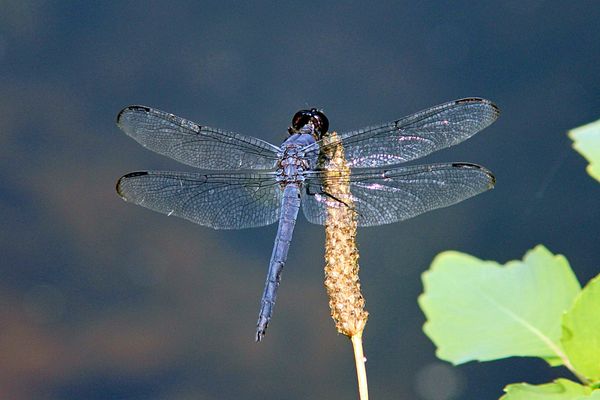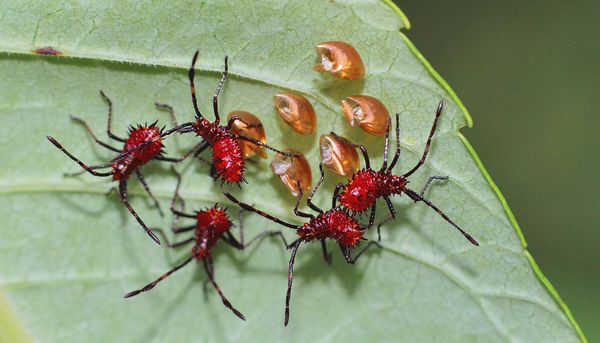A Few Summer Insects
Nov 22, 2016 22:11:59 #
Descriptions follow.
1. A very pregnant crane fly (I assume the genus Tipula). I used to think that crane flies bred only in the water, since I often do see their larvae there. But this female was far from any water and she could barely fly. I learned from wiser minds that the larvae of many crane fly species are found in detritus, so mystery solved.
2. The square-headed wasp, which may be Tachytes crassus. If I am right about the ID, then these wasps provision their burrow with paralyzed grasshoppers. This one stayed on this flower head for almost an hour, but was so active with constant pacing and turning that I was pretty exhausted trying to get a decent picture.
3. This is a slaty skimmer dragonfly, and I wonder what it did to deserve the name Libellula incesta. This lovely individual is a mature male. Young males and females are patterned with bold, light stripes.
4. I was delighted to find this charming scene of hatchling squash bugs (I think Euthochtha sp). Their bright warning colors probably advertise chemical protection.
1. A very pregnant crane fly (I assume the genus Tipula). I used to think that crane flies bred only in the water, since I often do see their larvae there. But this female was far from any water and she could barely fly. I learned from wiser minds that the larvae of many crane fly species are found in detritus, so mystery solved.
2. The square-headed wasp, which may be Tachytes crassus. If I am right about the ID, then these wasps provision their burrow with paralyzed grasshoppers. This one stayed on this flower head for almost an hour, but was so active with constant pacing and turning that I was pretty exhausted trying to get a decent picture.
3. This is a slaty skimmer dragonfly, and I wonder what it did to deserve the name Libellula incesta. This lovely individual is a mature male. Young males and females are patterned with bold, light stripes.
4. I was delighted to find this charming scene of hatchling squash bugs (I think Euthochtha sp). Their bright warning colors probably advertise chemical protection.
Nov 22, 2016 23:47:22 #
Nov 23, 2016 00:06:40 #
Nov 23, 2016 04:08:15 #
Nov 23, 2016 05:10:15 #
So nice to have some interesting information to back up your good images.
Nov 23, 2016 09:10:30 #
Nov 23, 2016 09:28:11 #
tinusbum wrote:
good shots,leaf footed bugs (squash bugs) my fav
Those were pretty hard to identify in Bugguide. From that source the eggs of leaf footed bugs (later stage nymphs & adults have flared out tibia) seem very different, and the hatchlings are not red. I had to do a lot of searching to decide that these are more of the squash bug sort of of bug.
Nov 23, 2016 09:40:12 #
Mark Sturtevant wrote:
Those were pretty hard to identify in Bugguide. From that source the eggs of leaf footed bugs (later stage nymphs & adults have flared out tibia) seem very different, and the hatchlings are not red. I had to do a lot of searching to decide that these are more of the squash bug sort of of bug.
squash bugs are a common name for leaf footed bugs

Nov 23, 2016 10:02:27 #
tinusbum wrote:
squash bugs are a common name for leaf footed bugs 

I know, but then there are the ones without the flared tibia. So rather than call them leaf footed bugs, I just call 'em squash bugs.
Nov 23, 2016 11:17:10 #
Nov 26, 2016 10:59:57 #
tinusbum wrote:
good shots,leaf footed bugs (squash bugs) my fav
I concur......five for five

Nov 26, 2016 15:00:08 #
I can relate to spending an hour to capture a shot. Nice set......
P.S. If your new to chasing dragon flies, a lot of times you can approach them from the front, so they see you. If approached from the side or back their sensors will pick you up and make them fly off.
P.S. If your new to chasing dragon flies, a lot of times you can approach them from the front, so they see you. If approached from the side or back their sensors will pick you up and make them fly off.
Nov 27, 2016 01:11:00 #
martinfisherphoto wrote:
I can relate to spending an hour to capture a shot. Nice set......
P.S. If your new to chasing dragon flies, a lot of times you can approach them from the front, so they see you.
P.S. If your new to chasing dragon flies, a lot of times you can approach them from the front, so they see you.
That is not what I would expect, but I can try it. My method for flighty insects is to always move very slowly, with no sudden movements, and if I need to change my angle to first step back well out of their scare zone before I move to the slide (slowly). Then I slowly move in closer.
My reasoning about why this may be a good way is that they are more sensitive to sideways movements since that creates a stimulus to different parts of the visual field, so those kinds of movements are kept far away. I assume they are less sensitive to movements coming straight toward them since that is mainly seen in the same visual field that has had a chance to acclimate to me. So there is less 'new' stimulus in that part of their visual field.
I have no idea if this reasoning is right, except that just sort of made sense. But I will try to remember your suggestion.
If you want to reply, then register here. Registration is free and your account is created instantly, so you can post right away.












